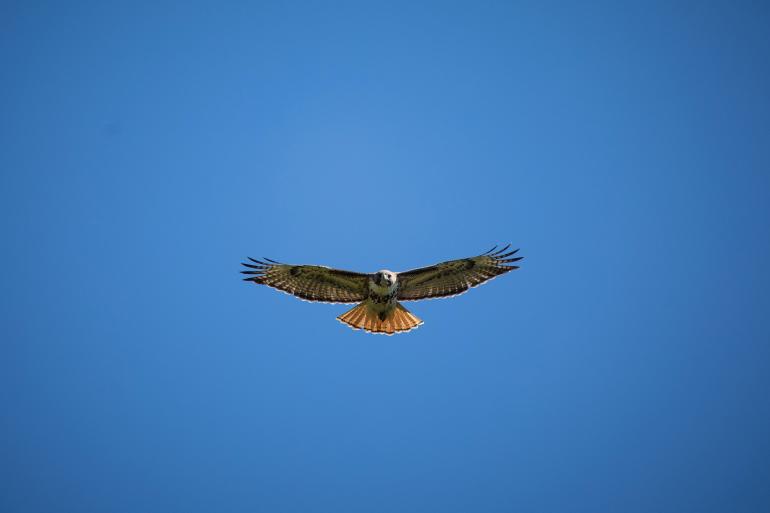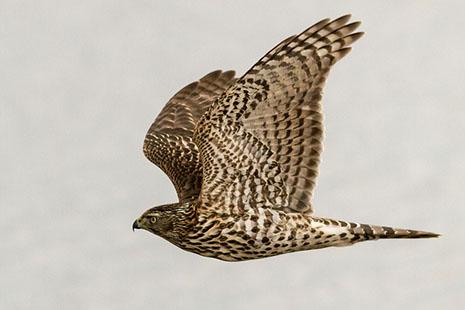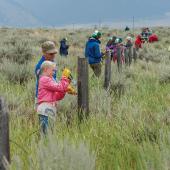Winged Migration
It’s not really spring until the birds return.
According to the Montana Audubon Society, the official Montana bird list contains 427 species, ranging from birds of prey such as the golden eagle, to shorebirds and waterfowl, to warblers and sparrows. Some of these are year-round Montana residents and have the wherewithal to put up with a five-month winter season. These stay-at-home birds include the black-capped chickadee, house finch, and the ever-resilient black-billed magpie. But for some of Montana’s avian representatives, residency is a part-time obligation.
The science behind bird migration is not fully understood. To many, the greatest wonder is not the amazing distances flown, or how they avoid exhaustion and injury. The greatest wonder, to ornithologists and bird enthusiasts alike, is simply that they don’t get lost.
We know that birds use numerous navigational tools during the course of their migratory journeys. For instance, they use the sun’s pathway across the sky as a compass. They can somehow sense the electromagnetic field of the earth. They can use the angle of polarized light to determine direction. They can use the infrasonic roar of distant ocean waves or wind from far-off mountains as acoustic landmarks. They even utilize their sense of smell to map their long journeys. Combining these numerous navigational tools (like any good pilot), they rarely get lost. And they find their way back.
The Mountain Bluebird
So, in the fall, off they go. And in the spring, back they come. And one day in early to mid-March, here in the Gallatin Valley, you’ll catch sight of them—a brilliant flash of blue that momentarily alights upon a fence post. If you’re lucky (and you likely will be), another blue flash soon joins. Looking almost grossly out of place in a world of brown and white, the mountain bluebird has returned to its summer home of Montana.
The mountain bluebird, otherwise known as Sialia currucoides, is a rather small member of the thrush family—some seven inches long but weighing little more than a single ounce. The adult male is a recognized by a bright, sky-blue head and upperparts. The belly and underparts are an attractive light blue. Females, similar in size, are more brownish-gray in their appearance. Records suggest that mountain bluebirds return to the Bozeman area on or around March 15 with some birds, most likely the females, delaying their return until the end of March or early April.
These avian migrants return to Montana for one reason: to quickly reproduce and rear a brood of chicks in a few short months. For mountain bluebirds, time is of the essence and nesting activity commences almost immediately upon their return. Mates are chosen and nests are refurbished. Soon thereafter, as early as late April, the first chicks hatch and the business of rearing the offspring begins in earnest. A notoriously short Montana summer leads to an early bluebird departure—with fall migration for the species beginning in late September. By the middle of October, all the bluebirds are gone—aiming for wintering grounds as far away as central Mexico.
The Sandhill Crane
As much as the mountain bluebird is a visual reminder that spring has arrived, it is the sound of sandhill cranes that audibly announces the transition to spring—you’ll most likely hear them before you see them. One late afternoon, sometime in early to mid-April, you’ll hear their distinctive squawk—a long, raspy vibrato, like a stuttering flute. You might not see them at first, because migrating flocks can fly at great heights—often too high to be seen. But they’re up there.
Grus canadensis is an eye-catching bird by anyone’s standards: four feet tall, a wingspan that exceeds five feet, and weighing an impressive ten pounds, you’d think they’d be easy to spot. And they are—once they land. The sandhill crane is elegantly built: long neck and legs, a clump of feathers draped over its rump. The adults are gray for the most part, with a white chin, neck, and upper throat. Dull red skin on the crown of the head completes the sandhill crane’s distinctive look.
As with the mountain bluebird, the sandhill returns to Montana to produce offspring. During mating, pairs vocalize in a behavior known as “unison calling.” They throw their heads back and unleash a passionate duet—what has been described as “an extended litany of coordinated song.” During this unison calling, sandhills also dance, run, leap high in the air, and otherwise cavort around (just like the rest of us during mating season). It is a sight to see!
Sandhills prefer to nest along small valley streams bordered by extensive moist meadows. Here the pairs build ground nests from assorted plant materials and the females then typically deposit two eggs. Upon hatching, the precocious young almost immediately join their parents as they forage for a variety of foods—from plants to mice, snakes, and worms. As with the bluebird, the sandhills migrate a thousand miles—in their case, to southern Texas and New Mexico—after mating.
By mid-October, the last of the sandhills are gone from the Bozeman area. But for now, it is spring. So get outside, take a walk, and look around. Listen quietly from your backyard. And recognize that brilliant flash of blue or that distant croak high above us in the sky for what it is—a joyous reminder that spring has once again returned to southwest Montana.
Greg Smith lives in Bozeman, and other than feeding and watching birds in his back yard during the winter months, he enjoys running, nordic skiing, and bicycling.
















